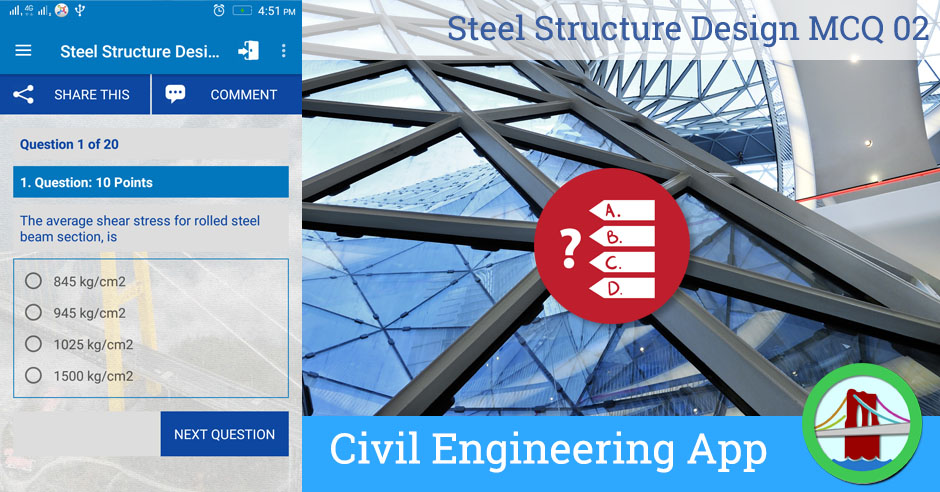Test your knowledge about Civil Engineering – Steel Structure Design by taking this Multi Choice Question (MCQ) quiz. Get your score and actual answers at the end of this quiz.
1. The average shear stress for rolled steel beam section, is
845 kg/cm2
945 kg/cm2
1025 kg/cm2
1500 kg/cm2
2. For a rectangular section, the ratio of the maximum and average shear stresses, is
1.5
2
2.5
3
3. The cross-section of a standard fillet is a triangle whose base angles are
45? and 45?
45? and 45?
40? and 50?
20? and 70?
4. Secant formula for direct stress in compression, is applicable only for slenderness ratio upto
120
130
140
150
5. A second horizontal stiffener is always placed at the neutral axis of the girder if the thickness of the web is less than
d/250 for structural steel
d/225 for high tensile steel
both (c) and (b)
neither (a) nor (b)
6. The rolled steel I-sections are most commonly used as beams because these provide
large moment of inertia with less cross-sectional area
large moment of resistance as compared to other section
greater lateral stability
all the above.
7.
For the steel member exposed to weather and accessible for repainting, the thickness of steel should not be less than (excepting the webs of Indian Standard rolled steel joists and channels).
4 mm
6 mm
8 mm
10 mm
8. The permissible stress in bending for rolled steel I-beams and channels, is
1500 kg/cm2
1575 kg/cm2
945 kg/cm2
1650 kg/cm2
9. The ratio of longitudinal stress to strain within eiastic limit, is known as
modulus of elasticity
shear modulus of elasticity
bulk modulus of elasticity
tangent modulus of elasticity
10. Net sectional area of a tension member, is equal to its gross section area
plus the area of the rivet holes
divided by the area of rivet holes
multiplied by the area of the rivet holes
minus the area of the rivet holes
11. The distance measured along one rivet line from the centre of a rivet to the centre of adjoining rivet on an adjacent parallel rivet line, is called
pitch of rivet
gauge distance of rivet
staggered pitch
all the above
12. Tongue plates are provided in a steel girder at
the upper flange
the lower flange
the upper end of the web
the upper and lower ends of the web.
13. The effective length L of a simply supported beam with ends restrained against torsion, and also the ends of compression flange partially restrained against lateral bending, is given by
L = span
L = 0.85 span
L = 0.75 span
L = 0.7 span
14. The spans are considered approximately equal if the longest span does not exceed the shortest span by more than
5%
10%
15%
20%
15. If the depth of the section of an upper column is smaller than the lower column
filler plates are provided with column splice
bearing plates are provided with column splice
neither filler plates nor bearing plates are provided with column splice
filler plates and bearing plates are provided with column splice
16. A tension member, if subjected to possible reversal of stress due to wind, the slenderness ratio of the member should not exceed
180
200
350
300
17. The permissible bearing stress in steel, is
1500 kg/cm2
1890 kg/cm2
2025 kg/cm2
2340 kg/cm2
18. In a fillet weld placed on the sides of the base, the metal experiences
shear
tension
compression
All of these.
19. The Indian standard code which deals with steel structures, is
IS : 875
IS : 800
IS : 456
IS : 1893
20. When two plates are placed end to end and are joined by two cover plates, the joint is known as
lap joint
butt joint
chain riveted lap joint
double cover butt joint.
Result
You have attempted 0 of 20 questions
Correct Answers : 0 of 20
Percentage Marks : 0%

